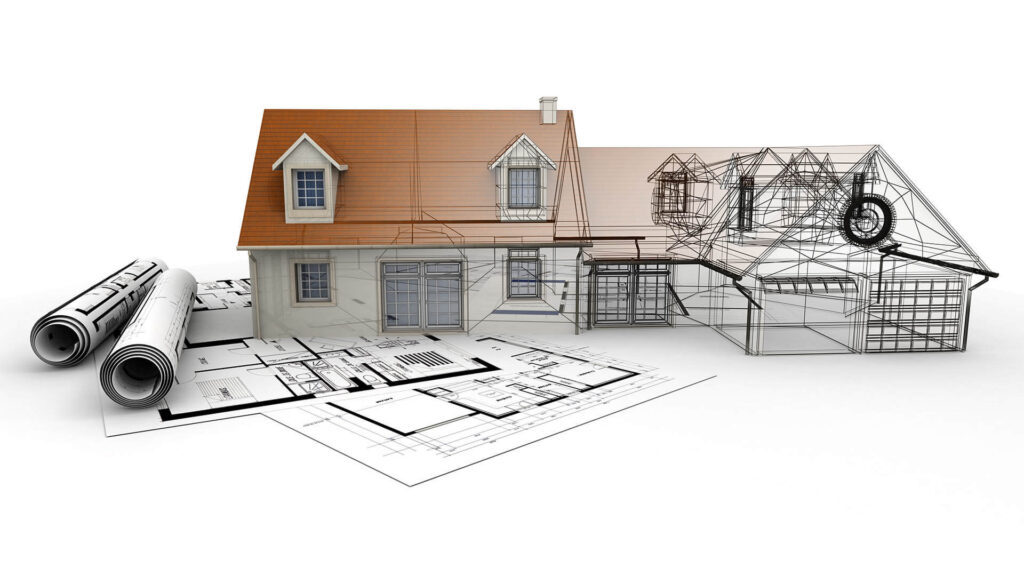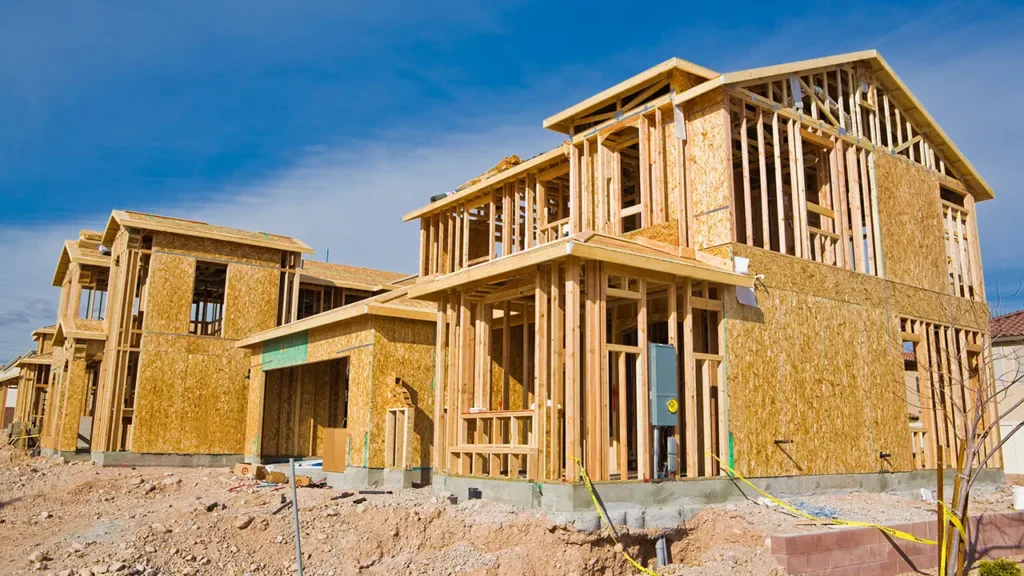Building a home goes beyond just erecting walls; it involves creating a durable and maintainable living space. This guide will walk you through the essential steps of home repair and maintenance, ensuring your home stands the test of time. I hope you received the answer to the question of how to build a home.
1. Planning and Designing for Maintenance Efficiency
First step of How to Build a Home. When envisioning the blueprint for your future home, it’s crucial to integrate maintenance efficiency from the get-go. This approach not only ensures the longevity of your property but also significantly reduces upkeep costs and efforts in the long run. Planning and designing for maintenance efficiency involve a thoughtful consideration of materials, layout, and systems within the home to ensure they are not only durable but also easy to repair and maintain.

Material Selection: The cornerstone of a maintenance-efficient home lies in the selection of materials. Opt for those that are renowned for their durability and ease of maintenance. For instance, quartz countertops in the kitchen, despite being slightly pricier, resist staining and require less upkeep compared to their granite counterparts. Similarly, vinyl siding or brick can offer a more maintenance-free exterior facade than traditional wood siding.
Layout Considerations
Designing a home with maintenance in mind also involves thoughtful layout planning. For instance, placing the utility room centrally can make it easier to perform regular maintenance on your home’s systems without causing disruption. Similarly, opting for a design that allows for ample natural light can reduce reliance on artificial lighting, but also consider the placement of windows to reduce the heat gain in hotter climates which can lead to increased air conditioning costs.
Systems for Simplified Maintenance: Incorporating systems that ease the maintenance burden is another critical aspect. This could include central vacuum systems, which are more efficient and reduce the need to carry a vacuum from room to room. Installing a drip irrigation system for landscaping can ensure that plants receive the right amount of water without the labor-intensive process of manual watering, and smart home systems can help monitor for maintenance needs proactively.
Incorporating ease of maintenance into your home’s design isn’t just about selecting the right materials or systems; it’s also about foreseeing potential future challenges and planning accordingly. Easy access to plumbing, electrical systems, and appliances for repair and maintenance, for example, should be a key consideration in the design phase. Think about the placement of these elements to ensure that repairs don’t require extensive labor to access or fix problems when they arise.
In conclusion, a well-thought-out approach to planning and designing for maintenance efficiency can significantly impact the ease of upkeep and the overall longevity of your home. By prioritizing durable materials, a thoughtful layout, and systems that simplify maintenance tasks, you can create a living space that not only stands the test of time but also allows you to enjoy your home rather than constantly maintaining it. Remember, the goal is to build a home that’s as efficient to maintain as it is beautiful to live in.
2. Choosing the Right Materials for Durability and Ease of Repair
2nd step of How to Build a Home. Selecting the right materials for your home is a critical decision that impacts not just the aesthetics but also the long-term durability and ease of maintenance. The choice of materials can significantly affect the overall resilience of your home to wear and tear, environmental conditions, and the ease with which repairs can be conducted. This section delves into how to make informed decisions on materials for various aspects of your home, ensuring a balance between durability, aesthetic appeal, and repair simplicity.

Foundation and Structural Components
The foundation and structural integrity of your home are paramount. Opt for materials known for their strength and longevity. Reinforced concrete, steel, and modern engineered wood products are top choices for their resistance to elements and pests. For areas prone to moisture or termite infestations, treated wood and moisture-resistant materials can provide added protection, reducing the need for frequent repairs.
Exterior Finishes: The materials you choose for the exterior of your home should withstand your local climate without requiring excessive maintenance. Brick and stone offer timeless appeal with minimal upkeep, while fiber cement siding is renowned for its durability and resistance to rot and pests. High-quality vinyl siding can also be a cost-effective option, offering a wide range of styles and colors with the benefit of being low maintenance.
Roofing Materials
Your roof is your home’s first line of defense against the elements. Materials like metal roofing or slate tiles, while initially more expensive, offer superior longevity and are more resistant to adverse weather conditions. They also tend to be more energy-efficient, reflecting sunlight and reducing cooling costs in warm climates. Asphalt shingles, while less costly upfront, may require more frequent replacements but can be a good option where budget constraints are a primary consideration.
Interior Finishes and Fixtures
Inside your home, choose materials that combine durability with ease of cleaning and repair. For flooring, consider porcelain or ceramic tiles in high-moisture areas like kitchens and bathrooms for their water resistance. Hardwood floors are durable for living areas, and when scratched, can be refinished rather than replaced. In terms of fixtures, opt for quality brands with readily available spare parts to simplify repairs. Quartz and granite countertops are preferred for their durability and ease of maintenance, resisting scratches and heat damage.
Windows and Doors: For windows and doors, energy efficiency, durability, and maintenance requirements should guide your material choice. Fiberglass and vinyl windows offer excellent insulation and are resistant to warping and rot, requiring minimal upkeep. Similarly, steel or fiberglass doors can provide security and durability with less maintenance compared to wood doors.
In conclusion, choosing the right materials for your home is a delicate balance between aesthetics, durability, and the ease of maintenance and repair. By selecting materials that are suited to your climate, intended use, and personal style, you can create a home that not only looks beautiful but also stands up to the test of time with minimal upkeep. Remember, investing in quality materials upfront can save you time, money, and hassle in the long run, making your home more enjoyable and less of a burden to maintain.
3. Implementing Preventive Maintenance Practices
3rd step of How to Build a Home.Preventive maintenance is the cornerstone of ensuring a home remains in top condition, minimizing the need for extensive repairs down the line. This section delves into practical strategies homeowners can adopt to prevent deterioration and maintain the integrity of their living spaces. By incorporating these practices, you can significantly extend the lifespan of your home’s components and systems, ensuring they function efficiently and effectively.
Regular Inspection and Maintenance Schedules
Creating a Maintenance Calendar: One of the first steps in preventive maintenance is to develop a comprehensive calendar that outlines all necessary home maintenance tasks and their frequency. This includes checking roofing for damages, cleaning gutters, inspecting plumbing for leaks, servicing heating and cooling systems, and checking the home’s foundation and exterior for any signs of wear and tear. By adhering to a regular schedule, you can catch and address minor issues before they escalate into major problems.
Professional Inspections: While many maintenance tasks are manageable on a DIY basis, certain inspections and services are best left to professionals. Annual or bi-annual inspections by certified professionals can help identify issues that may not be visible or apparent to the untrained eye. This includes in-depth checks of electrical systems, structural integrity, roofing, and foundational assessments. Investing in professional inspections can save money in the long run by preventing expensive repairs or replacements.
Energy Efficiency and Upgrades
Implementing energy-efficient upgrades is not only beneficial for the environment but also for the longevity and efficiency of your home’s systems. Consider upgrading to energy-efficient appliances, installing double-glazed windows to improve insulation, and adding additional insulation to attics and walls. These upgrades can reduce wear and tear on heating and cooling systems, lower utility bills, and contribute to a more sustainable household. Furthermore, modernizing systems and appliances can also prevent the likelihood of breakdowns and the need for repairs.

Adopting a Proactive Mindset
The essence of preventive maintenance lies in adopting a proactive rather than reactive approach to home care. This means regularly checking for potential issues, promptly addressing any signs of wear or damage, and updating or upgrading components before they fail. Encourage every household member to report any anomalies or concerns regarding the home’s condition. This collective vigilance can play a crucial role in maintaining a safe and comfortable living environment.
In conclusion, implementing preventive maintenance practices is an invaluable strategy for any homeowner. It not only ensures that your home remains a safe, comfortable, and efficient living space but also significantly contributes to reducing long-term repair and replacement costs. By following a regular maintenance schedule, investing in professional inspections, making energy-efficient upgrades, and fostering a proactive mindset towards home care, you can protect your investment and enjoy your home for many years to come. Remember, the key to a well-maintained home is consistent care and attention.
4. Tackling Common Home Repair Challenges
Last step of How to Build a Home. When you embark on the journey of building or maintaining a home, encountering repair challenges is inevitable. However, being prepared and knowledgeable about common issues can significantly ease the process. This section delves into strategies for effectively tackling common home repair challenges, ensuring your living space remains in top condition.
Understanding the Basics of Home Systems
Before you can effectively tackle any repair, understanding the basics of your home’s systems—electrical, plumbing, HVAC (Heating, Ventilation, and Air Conditioning), and structural components—is crucial. For instance, knowing how to shut off your home’s main water supply can prevent a minor leak from becoming a major flood. Similarly, familiarizing yourself with the electrical panel can allow you to safely reset circuits and replace fuses without needing professional help for minor issues.
DIY vs. Professional Help: While many minor repairs can be handled on a DIY basis, recognizing when to call in professionals can save you time and money in the long run. Tasks involving gas lines, major electrical work, and structural modifications often require specialized knowledge and certifications. Creating a network of trusted professionals before issues arise can provide peace of mind and expedite repairs when necessary.
Preventive Measures
Preventive measures can significantly reduce the frequency and severity of home repair challenges. Regularly cleaning gutters, for example, can prevent water damage to your roof and foundation. Sealing windows and doors can improve energy efficiency and prevent moisture intrusion, which can lead to mold and rot. Adopting a routine maintenance schedule for all major home systems can not only extend their lifespan but also reduce the likelihood of unexpected failures.
Dealing with Common Repairs
Some of the most common home repair challenges include leaking faucets, running toilets, clogged drains, peeling paint, and cracked drywall. While these issues might seem daunting, many can be resolved with basic tools and online tutorials. For instance, replacing the washer in a leaking faucet is a simple task that can prevent costly water waste. Learning to patch and paint drywall can also save hundreds of dollars in repair bills.
Importance of Quality Tools and Materials: Investing in quality tools and materials can make a significant difference in the effectiveness of your repairs. High-quality paints and primers, for instance, will provide better coverage and durability than cheaper alternatives. Similarly, using the right type of sealant for bathrooms can prevent mold growth and water damage. Building a basic toolkit with essentials like a hammer, screwdrivers, a drill, wrenches, and pliers can prepare you for a wide range of home repair tasks.
At this point, I hope you got the anwser for question How to Build a Home. In conclusion, tackling common home repair challenges requires a mix of knowledge, preparation, and the right tools. By understanding your home’s systems, knowing when to seek professional help, adopting preventive measures, and learning to handle minor repairs, you can maintain a comfortable and well-functioning home. Remember, the key to managing home repairs is not just in fixing problems as they arise but in preventing them where possible. A proactive approach to home maintenance can save you time, money, and stress, ensuring your home remains a source of joy and comfort. Share your journey on how to build a home.
Please register as a member at here to comment & contribute content.


